经典托福口语Task6.ppt
- 格式:ppt
- 大小:272.50 KB
- 文档页数:13
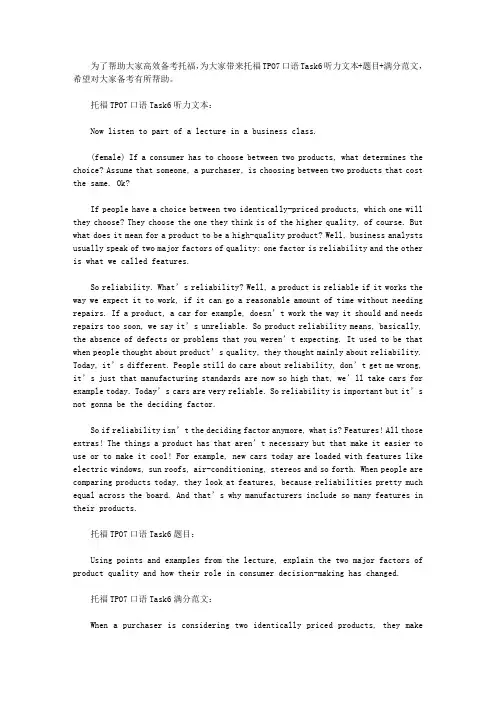
为了帮助大家高效备考托福,为大家带来托福TPO7口语Task6听力文本+题目+满分范文,希望对大家备考有所帮助。
托福TPO7口语Task6听力文本: Now listen to part of a lecture in a business class. (female) If a consumer has to choose between two products, what determines the choice? Assume that someone, a purchaser, is choosing between two products that cost the same. Ok? If people have a choice between two identically-priced products, which one will they choose? They choose the one they think is of the higher quality, of course. But what does it mean for a product to be a high-quality product? Well, business analysts usually speak of two major factors of quality: one factor is reliability and the other is what we called features. So reliability. What’s reliability? Well, a product is reliable if it works the way we expect it to work, if it can go a reasonable amount of time without needing repairs. If a product, a car for example, doesn’t work the way it should and needs repairs too soon, we say it’s unreliable. So product reliability means, basically, the absence of defects or problems that you weren’t expecting. It used to be that when people thought about product’s quality, they thought mainly about reliability. Today, it’s different. People still do care about reliability, don’t get me wrong, it’s just that manufacturing standards are now so high that, we’ll take cars for example today. Today’s cars are very reliable. So reliability is important but it’s not gonna be the deciding factor. So if reliability isn’t the deciding factor anymore, what is? Features! All those extras! The things a product has that aren’t necessary but that make it easier to use or to make it cool! For example, new cars today are loaded with features like electric windows, sun roofs, air-conditioning, stereos and so forth. When people are comparing products today, they look at features, because reliabilities pretty much equal across the board. And that’s why manufacturers include so many features in their products. 托福TPO7口语Task6题目: Using points and examples from the lecture, explain the two major factors of product quality and how their role in consumer decision-making has changed. 托福TPO7口语Task6满分范文: When a purchaser is considering two identically priced products, they makedecisions according to the quality. There are two major factors of product quality: reliability and features. A product is reliable when it works the way we expect. For example, if a car doesn’t work the way it should and it needs repair all the time, it is not reliable. So reliability means the absence of defects and problems. However, our concern with reliability is different now, manufacture standards are so high that products are all very reliable. So reliability is not a deciding factor anymore. Instead, features are becoming more important in making decisions. Features are extras and things aren’t necessary. Features make a product cool and easier to use. For example, in a car, features are electric windows, air conditioning and stereos. Since reliability of different products are almost equal, people care more about the features. 以上是给大家整理的托福TPO7口语Task6听力文本+题目+满分范文,希望对你有所帮助!。
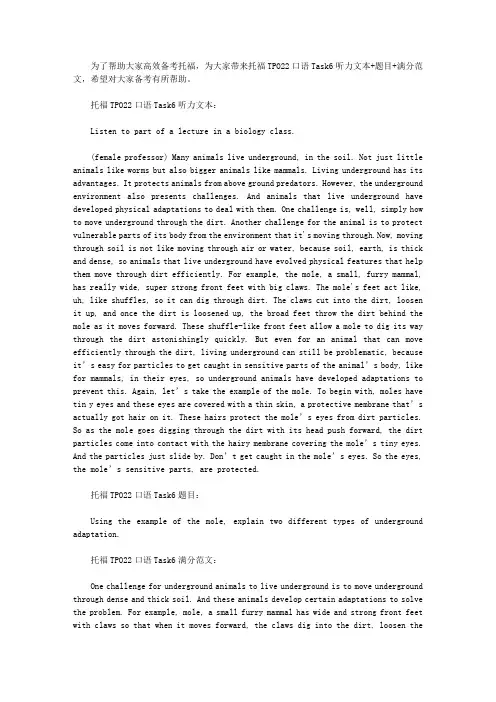
为了帮助大家高效备考托福,为大家带来托福TPO22口语Task6听力文本+题目+满分范文,希望对大家备考有所帮助。
托福TPO22口语Task6听力文本: Listen to part of a lecture in a biology class. (female professor) Many animals live underground, in the soil. Not just little animals like worms but also bigger animals like mammals. Living underground has its advantages. It protects animals from above ground predators. However, the underground environment also presents challenges. And animals that live underground have developed physical adaptations to deal with them. One challenge is, well, simply how to move underground through the dirt. Another challenge for the animal is to protect vulnerable parts of its body from the environment that it's moving through.Now, moving through soil is not like moving through air or water, because soil, earth, is thick and dense, so animals that live underground have evolved physical features that help them move through dirt efficiently. For example, the mole, a small, furry mammal, has really wide, super strong front feet with big claws. The mole's feet act like, uh, like shuffles, so it can dig through dirt. The claws cut into the dirt, loosen it up, and once the dirt is loosened up, the broad feet throw the dirt behind the mole as it moves forward. These shuffle-like front feet allow a mole to dig its way through the dirt astonishingly quickly. But even for an animal that can move efficiently through the dirt, living underground can still be problematic, because it’s easy for particles to get caught in sensitive parts of the animal’s body, like for mammals, in their eyes, so underground animals have developed adaptations to prevent this. Again, let’s take the example of the mole. To begin with, moles have tin y eyes and these eyes are covered with a thin skin, a protective membrane that’s actually got hair on it. These hairs protect the mole’s eyes from dirt particles. So as the mole goes digging through the dirt with its head push forward, the dirt particles come into contact with the hairy membrane covering the mole’s tiny eyes. And the particles just slide by. Don’t get caught in the mole’s eyes. So the eyes, the mole’s sensitive parts, are protected. 托福TPO22口语Task6题目: Using the example of the mole, explain two different types of underground adaptation. 托福TPO22口语Task6满分范文: One challenge for underground animals to live underground is to move underground through dense and thick soil. And these animals develop certain adaptations to solve the problem. For example, mole, a small furry mammal has wide and strong front feet with claws so that when it moves forward, the claws dig into the dirt, loosen thesoil and its broad feet will throw the soil behind. In this way it can move through the hard soil very quickly. Another challenge is to protect the vulnerable parts of their body while moving under the soil. Back to the mole, besides the claws, it develops hairy membrane on their tiny eyes. When the dirt and particles come into contacts with the membrane while the mole is moving forward in the dirt, they just slide by rather than get caught in the mole's eyes. In this way the mole manages to protect its sensitive eyes from the soil and particles. (157 words) 以上是给大家整理的托福TPO22口语Task6听力文本+题目+满分范文,希望对你有所帮助!。
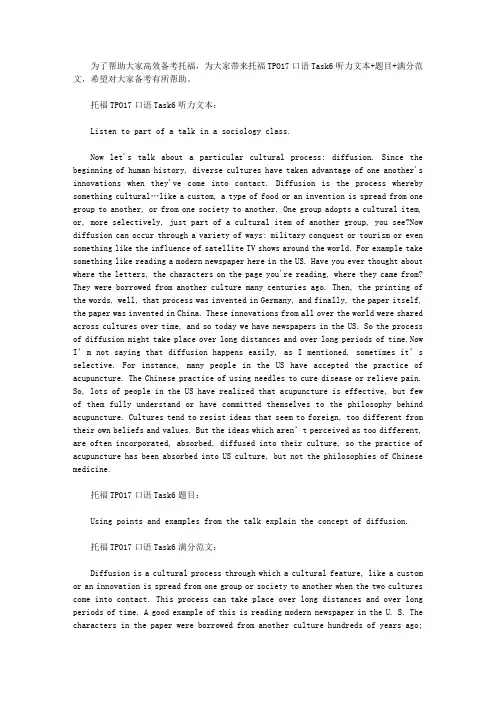
为了帮助大家高效备考托福,为大家带来托福TPO17口语Task6听力文本+题目+满分范文,希望对大家备考有所帮助。
托福TPO17口语Task6听力文本: Listen to part of a talk in a sociology class. Now let's talk about a particular cultural process: diffusion. Since the beginning of human history, diverse cultures have taken advantage of one another's innovations when they've come into contact. Diffusion is the process whereby something cultural…like a custom, a type of food or an invention is spread from one group to another, or from one society to another. One group adopts a cultural item, or, more selectively, just part of a cultural item of another group, you see?Now diffusion can occur through a variety of ways: military conquest or tourism or even something like the influence of satellite TV shows around the world. For example take something like reading a modern newspaper here in the US. Have you ever thought about where the letters, the characters on the page you're reading, where they came from? They were borrowed from another culture many centuries ago. Then, the printing of the words, well, that process was invented in Germany, and finally, the paper itself, the paper was invented in China. These innovations from all over the world were shared across cultures over time, and so today we have newspapers in the US. So the process of diffusion might take place over long distances and over long periods of time.Now I’m not saying that diffusion happens easily, as I mentioned, sometimes it’s selective. For instance, many people in the US have accepted the practice of acupuncture. The Chinese practice of using needles to cure disease or relieve pain. So, lots of people in the US have realized that acupuncture is effective, but few of them fully understand or have committed themselves to the philosophy behind acupuncture. Cultures tend to resist ideas that seem to foreign, too different from their own beliefs and values. But the ideas which aren’t perceived as too different, are often incorporated, absorbed, diffused into their culture, so the practice of acupuncture has been absorbed into US culture, but not the philosophies of Chinese medicine. 托福TPO17口语Task6题目: Using points and examples from the talk explain the concept of diffusion. 托福TPO17口语Task6满分范文: Diffusion is a cultural process through which a cultural feature, like a custom or an innovation is spread from one group or society to another when the two cultures come into contact. This process can take place over long distances and over long periods of time. A good example of this is reading modern newspaper in the U. S. The characters in the paper were borrowed from another culture hundreds of years ago;the printing was invented in Germany; then the paper itself was invented in China. However, the process of diffusion does not happen easily; it's selective. For example, the practice of Chinese acupuncture has been accepted by many people in the U. S. as an effective way of relieving pain and curing disease. But the philosophy behind it was hardly understood and accepted because the idea was too foreign, and people tend to resist the ideas that are too different from their own values and beliefs. (155 words) 以上是给大家整理的托福TPO17口语Task6听力文本+题目+满分范文,希望对你有所帮助!。
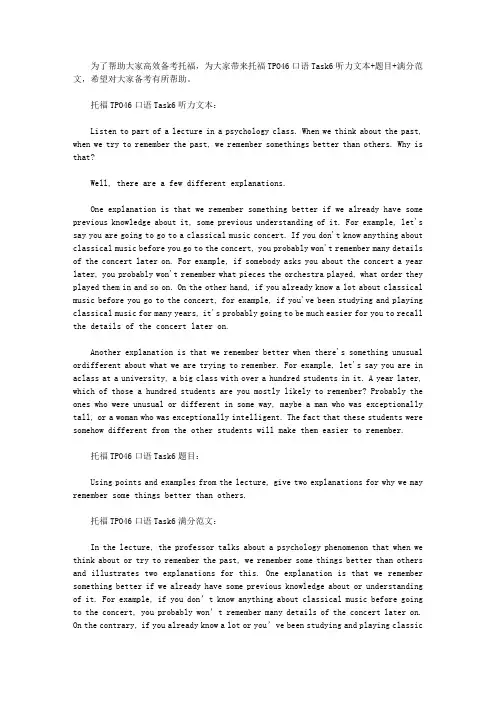
为了帮助大家高效备考托福,为大家带来托福TPO46口语Task6听力文本+题目+满分范文,希望对大家备考有所帮助。
托福TPO46口语Task6听力文本: Listen to part of a lecture in a psychology class. When we think about the past, when we try to remember the past, we remember somethings better than others. Why is that? Well, there are a few different explanations. One explanation is that we remember something better if we already have some previous knowledge about it, some previous understanding of it. For example, let's say you are going to go to a classical music concert. If you don't know anything about classical music before you go to the concert, you probably won't remember many details of the concert later on. For example, if somebody asks you about the concert a year later, you probably won't remember what pieces the orchestra played, what order they played them in and so on. On the other hand, if you already know a lot about classical music before you go to the concert, for example, if you've been studying and playing classical music for many years, it's probably going to be much easier for you to recall the details of the concert later on. Another explanation is that we remember better when there's something unusual ordifferent about what we are trying to remember. For example, let's say you are in aclass at a university, a big class with over a hundred students in it. A year later, which of those a hundred students are you mostly likely to remember? Probably the ones who were unusual or different in some way, maybe a man who was exceptionally tall, or a woman who was exceptionally intelligent. The fact that these students were somehow different from the other students will make them easier to remember. 托福TPO46口语Task6题目: Using points and examples from the lecture, give two explanations for why we may remember some things better than others. 托福TPO46口语Task6满分范文: In the lecture, the professor talks about a psychology phenomenon that when we think about or try to remember the past, we remember some things better than others and illustrates two explanations for this. One explanation is that we remember something better if we already have some previous knowledge about or understanding of it. For example, if you don’t know anything about classical music before going to the concert, you probably won’t remember many details of the concert later on. On the contrary, if you already know a lot or you’ve been studying and playing classicmusic for many years, it’s probably going to be easier to recall the details later on. Another explanation is that we remember better when there’s something unusual or different about what we are trying to remember. For example, you will probably only remember the ones who were unusual or different in a big class with over a hundred students a year later. 以上是给大家整理的托福TPO46口语Task6听力文本+题目+满分范文,希望对你有所帮助!。

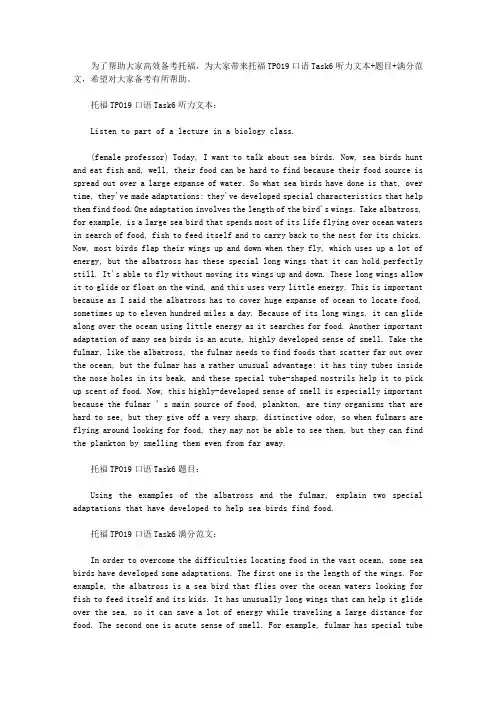
为了帮助大家高效备考托福,为大家带来托福TPO19口语Task6听力文本+题目+满分范文,希望对大家备考有所帮助。
托福TPO19口语Task6听力文本: Listen to part of a lecture in a biology class. (female professor) Today, I want to talk about sea birds. Now, sea birds hunt and eat fish and, well, their food can be hard to find because their food source is spread out over a large expanse of water. So what sea birds have done is that, over time, they've made adaptations: they've developed special characteristics that help them find food.One adaptation involves the length of the bird's wings. Take albatross, for example, is a large sea bird that spends most of its life flying over ocean waters in search of food, fish to feed itself and to carry back to the nest for its chicks. Now, most birds flap their wings up and down when they fly, which uses up a lot of energy, but the albatross has these special long wings that it can hold perfectly still. It's able to fly without moving its wings up and down. These long wings allow it to glide or float on the wind, and this uses very little energy. This is important because as I said the albatross has to cover huge expanse of ocean to locate food, sometimes up to eleven hundred miles a day. Because of its long wings, it can glide along over the ocean using little energy as it searches for food. Another important adaptation of many sea birds is an acute, highly developed sense of smell. Take the fulmar, like the albatross, the fulmar needs to find foods that scatter far out over the ocean, but the fulmar has a rather unusual advantage: it has tiny tubes inside the nose holes in its beak, and these special tube-shaped nostrils help it to pick up scent of food. Now, this highly-developed sense of smell is especially important because the fulmar ’s main source of food, plankton, are tiny organisms that are hard to see, but they give off a very sharp, distinctive odor, so when fulmars are flying around looking for food, they may not be able to see them, but they can find the plankton by smelling them even from far away. 托福TPO19口语Task6题目: Using the examples of the albatross and the fulmar, explain two special adaptations that have developed to help sea birds find food. 托福TPO19口语Task6满分范文: In order to overcome the difficulties locating food in the vast ocean, some sea birds have developed some adaptations. The first one is the length of the wings. For example, the albatross is a sea bird that flies over the ocean waters looking for fish to feed itself and its kids. It has unusually long wings that can help it glide over the sea, so it can save a lot of energy while traveling a large distance for food. The second one is acute sense of smell. For example, fulmar has special tubein its nostril/nose hole to help it pick up the scent of its food, plankton. The plankton is very tiny so the fulmar cannot see it, but it gives out a special odor that fulmar's nose is sensitive to, and thus when the fulmar recognizes the smell of the plankton, it can locate and eat the plankton easily. (147 words) 以上是给大家整理的托福TPO19口语Task6听力文本+题目+满分范文,希望对你有所帮助!。
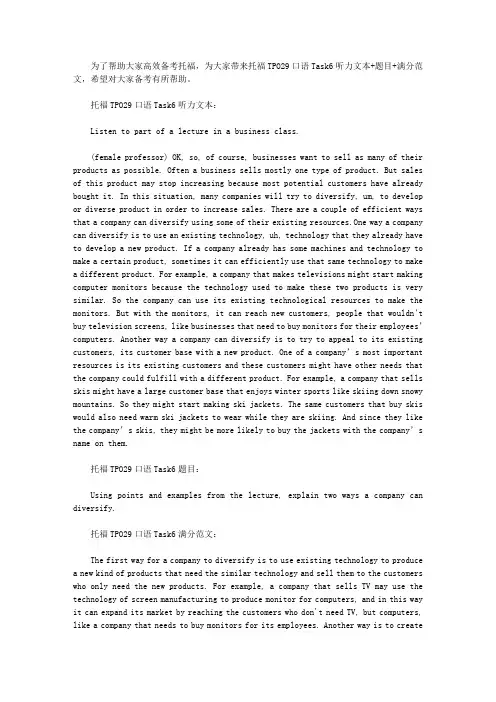
为了帮助大家高效备考托福,为大家带来托福TPO29口语Task6听力文本+题目+满分范文,希望对大家备考有所帮助。
托福TPO29口语Task6听力文本: Listen to part of a lecture in a business class. (female professor) OK, so, of course, businesses want to sell as many of their products as possible. Often a business sells mostly one type of product. But sales of this product may stop increasing because most potential customers have already bought it. In this situation, many companies will try to diversify, um, to develop or diverse product in order to increase sales. There are a couple of efficient ways that a company can diversify using some of their existing resources.One way a company can diversify is to use an existing technology, uh, technology that they already have to develop a new product. If a company already has some machines and technology to make a certain product, sometimes it can efficiently use that same technology to make a different product. For example, a company that makes televisions might start making computer monitors because the technology used to make these two products is very similar. So the company can use its existing technological resources to make the monitors. But with the monitors, it can reach new customers, people that wouldn’t buy television screens, like businesses that need to buy monitors for their employees’computers. Another way a company can diversify is to try to appeal to its existing customers, its customer base with a new product. One of a company’s most important resources is its existing customers and these customers might have other needs that the company could fulfill with a different product. For example, a company that sells skis might have a large customer base that enjoys winter sports like skiing down snowy mountains. So they might start making ski jackets. The same customers that buy skis would also need warm ski jackets to wear while they are skiing. And since they like the company’s skis, they might be more likely to buy the jackets with the company’s name on them. 托福TPO29口语Task6题目: Using points and examples from the lecture, explain two ways a company can diversify. 托福TPO29口语Task6满分范文: The first way for a company to diversify is to use existing technology to produce a new kind of products that need the similar technology and sell them to the customers who only need the new products. For example, a company that sells TV may use the technology of screen manufacturing to produce monitor for computers, and in this way it can expand its market by reaching the customers who don't need TV, but computers, like a company that needs to buy monitors for its employees. Another way is to createa new product and sell it to its existing customers who may have other needs. For example, a company selling skis may also produce ski-jackets and sell them to the consumers that have already bought their skis. Now that these customers must enjoy winter sports like skiing on snowy mountain, they will also need snow jackets to keep warm. And their preference of the ski brand will lead to their purchase of snow-jackets of the same brand. (168 words) 以上是给大家整理的托福TPO29口语Task6听力文本+题目+满分范文,希望对你有所帮助!。
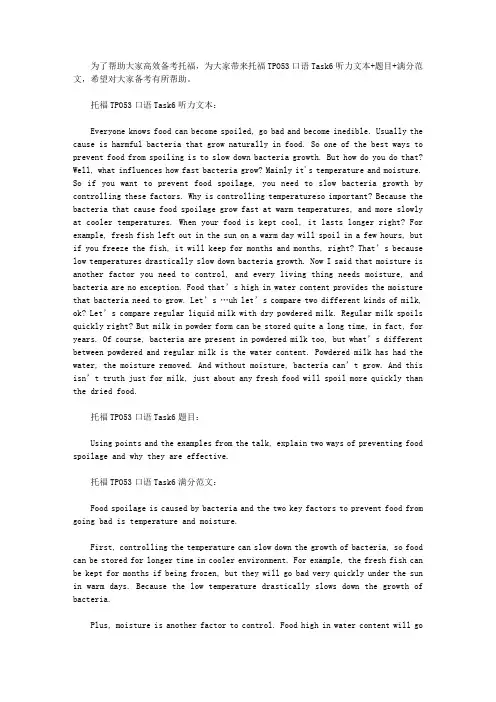
为了帮助大家高效备考托福,为大家带来托福TPO53口语Task6听力文本+题目+满分范文,希望对大家备考有所帮助。
托福TPO53口语Task6听力文本: Everyone knows food can become spoiled, go bad and become inedible. Usually the cause is harmful bacteria that grow naturally in food. So one of the best ways to prevent food from spoiling is to slow down bacteria growth. But how do you do that? Well, what influences how fast bacteria grow? Mainly it's temperature and moisture. So if you want to prevent food spoilage, you need to slow bacteria growth by controlling these factors. Why is controlling temperatureso important? Because the bacteria that cause food spoilage grow fast at warm temperatures, and more slowly at cooler temperatures. When your food is kept cool, it lasts longer right? For example, fresh fish left out in the sun on a warm day will spoil in a few hours, but if you freeze the fish, it will keep for months and months, right? That’s because low temperatures drastically slow down bacteria growth. Now I said that moisture is another factor you need to control, and every living thing needs moisture, and bacteria are no exception. Food that’s high in water content provides the moisture that bacteria need to grow. Let’s …uh let’s compare two different kinds of milk, ok? Let’s compare regular liquid milk with dry powdered milk. Regular milk spoils quickly right? But milk in powder form can be stored quite a long time, in fact, for years. Of course, bacteria are present in powdered milk too, but what’s different between powdered and regular milk is the water content. Powdered milk has had the water, the moisture removed. And without moisture, bacteria can’t grow. And this isn’t truth just for milk, just about any fresh food will spoil more quickly than the dried food. 托福TPO53口语Task6题目: Using points and the examples from the talk, explain two ways of preventing food spoilage and why they are effective. 托福TPO53口语Task6满分范文: Food spoilage is caused by bacteria and the two key factors to prevent food from going bad is temperature and moisture. First, controlling the temperature can slow down the growth of bacteria, so food can be stored for longer time in cooler environment. For example, the fresh fish can be kept for months if being frozen, but they will go bad very quickly under the sun in warm days. Because the low temperature drastically slows down the growth of bacteria. Plus, moisture is another factor to control. Food high in water content will gobad more quickly, because the moisture offers the bacteria necessary supplies to grow. For example, the liquid milk spoils quickly than the powdered milk. Because the water has been removed from the powdered milk, and without moisture, bacteria can’t grow. 以上是给大家整理的托福TPO53口语Task6听力文本+题目+满分范文,希望对你有所帮助!。
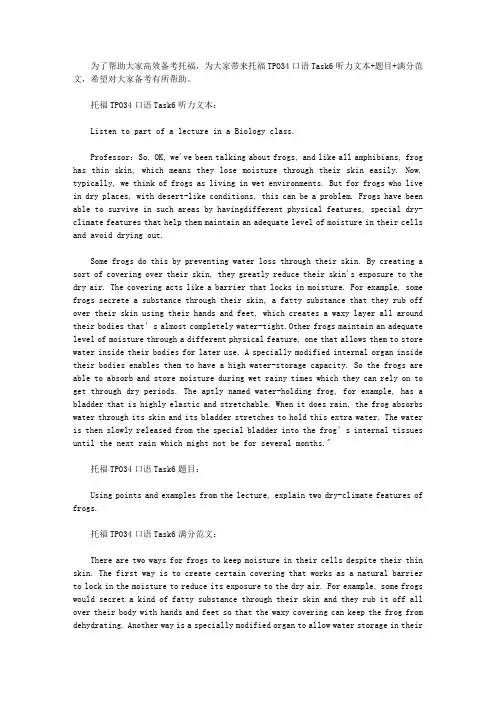
为了帮助大家高效备考托福,为大家带来托福TPO34口语Task6听力文本+题目+满分范文,希望对大家备考有所帮助。
托福TPO34口语Task6听力文本: Listen to part of a lecture in a Biology class. Professor:So, OK, we've been talking about frogs, and like all amphibians, frog has thin skin, which means they lose moisture through their skin easily. Now, typically, we think of frogs as living in wet environments. But for frogs who live in dry places, with desert-like conditions, this can be a problem. Frogs have been able to survive in such areas by havingdifferent physical features, special dry-climate features that help them maintain an adequate level of moisture in their cells and avoid drying out. Some frogs do this by preventing water loss through their skin. By creating a sort of covering over their skin, they greatly reduce their skin's exposure to the dry air. The covering acts like a barrier that locks in moisture. For example, some frogs secrete a substance through their skin, a fatty substance that they rub off over their skin using their hands and feet, which creates a waxy layer all around their bodies that’s almost completely water-tight.Other frogs maintain an adequate level of moisture through a different physical feature, one that allows them to store water inside their bodies for later use. A specially modified internal organ inside their bodies enables them to have a high water-storage capacity. So the frogs are able to absorb and store moisture during wet rainy times which they can rely on to get through dry periods. The aptly named water-holding frog, for example, has a bladder that is highly elastic and stretchable. When it does rain, the frog absorbs water through its skin and its bladder stretches to hold this extra water. The water is then slowly released from the special bladder into the frog’s internal tissues until the next rain which might not be for several months." 托福TPO34口语Task6题目: Using points and examples from the lecture, explain two dry-climate features of frogs. 托福TPO34口语Task6满分范文: There are two ways for frogs to keep moisture in their cells despite their thin skin. The first way is to create certain covering that works as a natural barrier to lock in the moisture to reduce its exposure to the dry air. For example, some frogs would secret a kind of fatty substance through their skin and they rub it off all over their body with hands and feet so that the waxy covering can keep the frog from dehydrating. Another way is a specially modified organ to allow water storage in theirbody for use during dry days. For example, the water-holding frog has a unique bladder that is stretchable. When it rains, it soaks in water and holds it in its body so that the water can then be released into its internal tissues before the next rain, which will probably be quite a while. (147 words) 以上是给大家整理的托福TPO34口语Task6听力文本+题目+满分范文,希望对你有所帮助!。
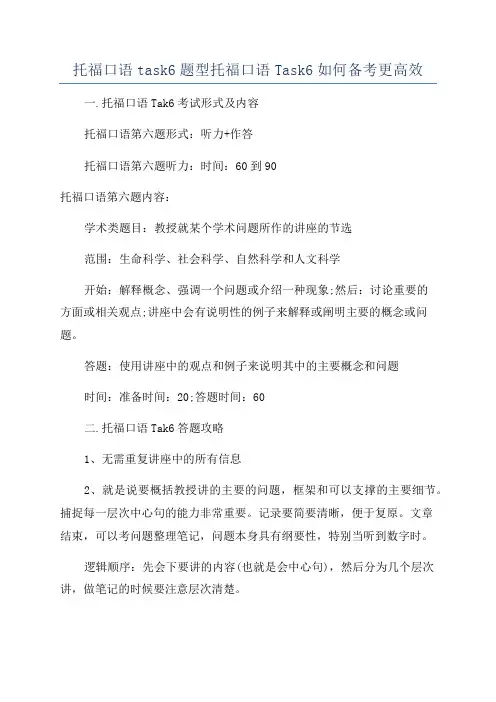
托福口语task6题型托福口语Task6如何备考更高效一.托福口语Tak6考试形式及内容托福口语第六题形式:听力+作答托福口语第六题听力:时间:60到90托福口语第六题内容:学术类题目:教授就某个学术问题所作的讲座的节选范围:生命科学、社会科学、自然科学和人文科学开始:解释概念、强调一个问题或介绍一种现象;然后:讨论重要的方面或相关观点;讲座中会有说明性的例子来解释或阐明主要的概念或问题。
答题:使用讲座中的观点和例子来说明其中的主要概念和问题时间:准备时间:20;答题时间:60二.托福口语Tak6答题攻略1、无需重复讲座中的所有信息2、就是说要概括教授讲的主要的问题,框架和可以支撑的主要细节。
捕捉每一层次中心句的能力非常重要。
记录要简要清晰,便于复原。
文章结束,可以考问题整理笔记,问题本身具有纲要性,特别当听到数字时。
逻辑顺序:先会下要讲的内容(也就是会中心句),然后分为几个层次讲,做笔记的时候要注意层次清楚。
3、这部分被认为是最难的一个部分,因为关键学术语汇的听辨和记录复述是答题的重要挑战。
因此在听力中一定要注意听懂讲座在想说明什么,重点在于抓住演讲者的观点和例子。
4、本部分的备考套路大多为:现象----举例式,概念----应用式,过程---作用式.因此在听力一开始,迅速判断听力属于三个模式中的哪一种,这对于我们预测文章内容并听懂内容有很大的帮助,笔记也要按照这种模式相应的展开。
其实Tak6的难点主要是听力部分内容的归纳,以及根据题目来进行回答问题,所以大家在备考的时候要练好听力,能够记录下来听力材料中的要点,然后可以根据答题套路整理自己的答题模板帮助自己快速组织答案。
Tak6是托福口语的压轴题,难度自然也要略高于其他口语题目,所以大家要重视起来,认真备考。
托福备考之口语的四种评分标准托福口语评分标准一、准确性准确性强调要准确挖掘与获取听、读材料的中心与细节内容,不能任凭主观臆想;同时还要注意用准确的语言输出。
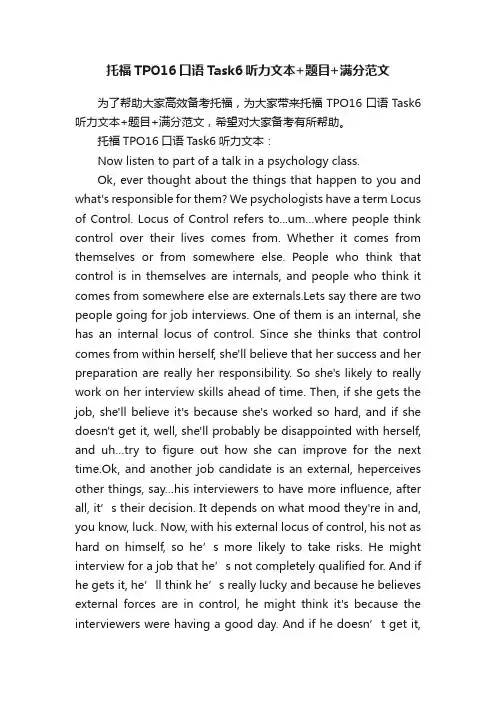
托福TPO16口语Task6听力文本+题目+满分范文为了帮助大家高效备考托福,为大家带来托福TPO16口语T ask6听力文本+题目+满分范文,希望对大家备考有所帮助。
托福TPO16口语Task6听力文本:Now listen to part of a talk in a psychology class.Ok, ever thought about the things that happen to you and what's responsible for them? We psychologists have a term Locus of Control. Locus of Control refers to...um…where people think control over their lives comes from. Whether it comes from themselves or from somewhere else. People who think that control is in themselves are internals, and people who think it comes from somewhere else are externals.Lets say there are two people going for job interviews. One of them is an internal, she has an internal locus of control. Since she thinks that control comes from within herself, she'll believe that her success and her preparation are really her responsibility. So she's likely to really work on her interview skills ahead of time. Then, if she gets the job, she'll believe it's because she's worked so hard, and if she doesn't get it, well, she'll probably be disappointed with herself, and uh…try to figure out how she can improve for the next time.Ok, and another job candidate is an external, heperceives other things, say…his interviewers to have more influence, after all, it’s their decision. It depends on what mood they're in and, you know, luck. Now, with his external locus of control, his not as hard on himself, so he’s more likely to take risks. He might interview for a job that he’s not completely qualified for. And if he gets it, he’ll think he’s really lucky and because he believes external forces are in control, he might think it's because the interviewers were having a good day. And if he doesn’t get it,he’ll probably blame the inter viewers or bad luck rather than look at himself and try to figure out what he could have done better.托福TPO16口语Task6题目:Using points and examples from the talk explain internal and external locus of control.托福TPO16口语Task6满分范文:Internal locus of control means the belief that the control comes from oneself rather than external force, and thus the person who has it will attribute their success to their personal effort. For example, if a woman with internal locus of control goes to a job interview, she'll work very hard to prepare for the interview ahead of time. If she gets the job, she'll attribute it all to her own effort. But if she doesn't, she may be upset about herself and try to figure out why she fails and how to improve the next time. However, external locus of control is different. The person with it believes in the decisive role of external forces. For example, a man with externallocus of control will attribute his success of a job interview to the interviewer's good mood and luck rather than his own effort, or blame his failure for bad luck or the interviewers instead of his own problem. And he won't even try to improve himself for the next time. (183 words)以上是给大家整理的托福TPO16口语T ask6听力文本+题目+满分范文,希望对你有所帮助!。
为了帮助大家高效备考托福,为大家带来托福TPO49口语Task6听力文本+题目+满分范文,希望对大家备考有所帮助。
托福TPO49口语Task6听力文本: Narrator: Listen to part of a lecture in a biology class. Professor: So of course many animals live in groups with others of their species. And there are benefits to living together in groups. It can help animals survive. But there are also certain disadvantages. So today we are going to talk about two disadvantages of living in groups for animals. One disadvantage is that animals that live in groups may be more visible to predators. If there's a big group of animals, predators are more likely to spot them than they would an individual animal on its own. So sometimes animals in a group may be more vulnerable to being captured by predators. For instance, Sardines, really small fish, swim in groups, and other larger ocean animals, like some kind of whales, eat them. So while a whale probably wouldn’t notice one Sardine, it would see a group of Sardines very easily and thus be able to capture them for food. Another disadvantage has to do with caring for the young. In a large group, there are a lot of young animals around and it can be difficult for animals to find or identify their own young. And they may end up taking care of other animals to young instead. So their own young may not get the care they need. For example, some bats live in caves. And with one type of bat, millions of them live together in the same cave. And with young bats so crowded together in the cave. It's sometimes hard for a mother bat to find her babies. So when a mother bat returns from finding food to feed her babies, she might end up feeding the babies of another mother bat, meaning her own babies don’t get fed. 托福TPO49口语Task6题目: Using points and examples from the lecture, explain two disadvantages of living in groups for animals. 托福TPO49口语Task6满分范文: The lecture is focusing on two disadvantages of living in a group for animals. One disadvantage is that animals living in groups are more visible and vulnerable to predators. Take sardines as an example. They swim in groups and they are prey for some large animals such as whales. Although it may be hard for a whale to notice one little Sardine, it is able to see a group of them and capture them for food. Another disadvantage is that living in groups set great barriers for animals to identify their own young and thus have them in good care. For example, one type of bats live togetherin the same cave with millions of them. With too much bats in the same cave, a mother bat may find it’s hard to find her own baby and she may end up feeding the babies of another mother bat, leaving her own babies with no food. 以上是给大家整理的托福TPO49口语Task6听力文本+题目+满分范文,希望对你有所帮助!。
1)----Well,in my opinion,I would definitely agree with the point that,____________________.The first reason that I wanna say is that____________________.More importantly,____________________.So,that’s why I choose____________________for the two reasons listed above2)----Personally speaking,I prefer…for several reasons.I think…is more appropriate for…for several reasons.Firstly,…Besides,in my experienceBut probably the most important reason for my preference is that…In a word,that’s the reason of my preference./that’s why my preference is…3)----I think it is important to…For one thing,….By doing…Another thing is the advantage of…As for…I agree that,but unless…,…1)----The school has implemented a new policy that________________due to ____________________。
And the man/woman holds a positive/negative view towards the announcement.The first reason s/he gives is that____________________.And the second one is based on the fact that____________________. Therefore,s/he agrees/disagrees with that opinion。
为了帮助大家高效备考托福,为大家带来托福TPO37口语Task6听力文本+题目+满分范文,希望对大家备考有所帮助。
托福TPO37口语Task6听力文本: Listen to part of a lecture from an art history class. So last class we were talking a bit about the history of photography and as I was saying, with the invention of the camera in the mid to late 1800s, for the first time people were able to record realistic images. Up until then, painting, portraits, landscapes, were the way that realistic images were recorded; the image of a person's face, the painting of a mountain range, but with the invention of the camera, now there was this new piece of technology; this machine that took realistic images and this had an enormous effect on painting. One effect was that painters began using photographs as a tool; a tool to help them paint more realistically. Before the camera, it was extremely difficult to realistically depict a moving object in a painting, but now photography was able to capture fleeting moments; freeze them in time and painters were able to use these photographs as a basis for their paintings. For example, the legs of a horse as its running. Photography could now capture the exact position of a horse's legs in midair, which a painter could use to more realistically create a painting of horses galloping. Photography also affected painting in a more conceptual way. The fact that cameras could now perfectly record realistic images led some painters to change their style; to stop painting realistically and adopt a more abstract way of painting. An abstract style enabled painters to contrast their art with photography, to set their art apart from the art of photography. They didn't want their paintings to look anything like photographs. They wanted their art to be more imaginative, more abstract. For example, if a painter were painting people f he or she might not use natural skin tones for the skin and instead paint the people's skin unnatural colors, like green, purple, or blue, which of course is not realistic. 托福TPO37口语Task6题目: Using points and examples from the lecture, explain two ways that photography affected painting. 托福TPO37口语Task6满分范文: In this lecture, the professor talks about two ways in which photography affects painting. First is photography began to be used as a tool helping painters to paint much realistically because photography can capture freezing moments and these can be used as basis for paintings. Such as the pictures of horse legs as running. It can provide the exact position of horse legs to the painters. The second way is photography made painters to gradually adopt abstract style. They wanted to set them apart from photography. For example, when those painters painted human, they woulduse unnatural colors to depict people’s skin such as blue and green which was different from natural colors. 以上是给大家整理的托福TPO37口语Task6听力文本+题目+满分范文,希望对你有所帮助!。
托福TPO4口语Task6题目文本及答案解析TPO对于我们的托福备考特别有用,大家还在苦于找不到资料吗?下面我给大家带来托福TPO4口语Task6题目文本及答案解析,期望可以帮忙到你们。
托福TPO4口语task6题目 Listening Part:Listen to part of a talk in an Art Appreciation class.Professor (female)In order for art to communicate, to appeal to the emotions or the intellect, it has to combine various visual elements to express meaning or emotion. It’s really the visual components of the work, things like color, texture, shape, lines and how these elements work together that tell us something about the work.Artists combine and manipulate these visual elements to express a message or to create a mood. Think about how a painter might use colors, for example. You all know from experience that different colors appeal in different ways to the senses and can convey different meanings. An artist chooses certain colors to evoke a particular mood and make powerful statements. The color red, for example, is a strong color, and can conjure up strong emotions such as extreme joy or excitement or even anger. Blue, on the other hand, is considered a cool color. Blue colors tend to have a calming effect on viewers.Another visual element important to art is texture. By texture I mean surface quality or feel of the work, its smoothness or roughness or softness. Now, of course, in some types of art the texture is physical. It can be actually be touched by the fingers. But in painting, for example, texture can be visual. The way an artist paints certain areas of the painting can create the illusion of texture, an object’s smoothness or roughness or softness. A rough texture can evoke stronger emotions and strength while a smooth texture is more calming and less emotional.As I said earlier, artists often combine elements to convey a message about the work. Take a painting that, say, uses a lot of strong colors like reds and oranges and uses brush stokes that are broad, wide sweeping brush strokes that suggest a rough texture.Well, these elements together can convey a wilder more chaotic emotion in the viewer than, more than say a painting with tiny, smooth brush strokes and soft or pale colors. Artists use these visual effects and the senses they arouse to give meaning to their work.托福TPO4口语task6 答案解析:Using points and examples from the lecture, explain the importance of visual elements in painting.托福TPO4口语task6 答案解析:1. Listening key(1.1) Main idea: how artists use color and texture to express emotions(1.2) Color(1.2.1) Color red: strong emotions like joy or excitement(1.2.2) Color blue: ease and comfort(1.3) Texture(1.3.1) Rough texture: strong emotions and strength(1.3.2) Fine texture: less emotional(1.4) Combined(1.4.1) Red+ wide brush strokes: chaotic and wild(1.4.2) Pale color+ smooth brush strokes: peaceful emotions托福TPO4口语task6 (范文):In the lecture, the professor talks about how artists use two elements to express meaning or emotions. The first is color. For example, the color red can express strong emotions and powerful statement, such as extreme joy or excitement, even anger. A calming color such as blue would give the viewer the feeling of ease and comfort. The other element is texture. Whenusing rough texture, artists can evoke strong emotions and strength, while a smooth texture is less emotional. They can work together too. For example, a wide, rough brush stroke combined with red or orange creates the feeling of chaotic and wild. While a tiny, smooth brush stroke and soft color can express peaceful emotions.托福TPO4口语Task6题目文本及答案解析文档内容到此结束,欢迎大家下载、修改、丰富并分享给更多有需要的人。
为了帮助大家高效备考托福,为大家带来托福TPO31口语Task6听力文本+题目+满分范文,希望对大家备考有所帮助。
托福TPO31口语Task6听力文本: Listen to part of a lecture in a Biology class. (Professor) Even though it's cold and snow-covered, the Arctic houses many species of animals that manage to survive the harsh conditions there. These Arctic animals have adapted to the extremely cold temperatures primarily because of certain body features that help them to survive in the cold Arctic climate. Let's look at a few of them. For one thing, many Arctic animals have developed a protective covering on their feet. The covering usually consists of fur or feathers which act as a protective layer between the cold and the animals' skin. Since they spend so much of their time on snowy, icy surfaces, whether they are standing on the ground or swimming in the water, they can easily lose heat through their feet. This is especially true of Arctic birds. A bird like the Arctic Snowy Owl, for example, has feathers on its body the way other birds do. But unlike most birds, it also has feathers all over its feet. This shields and protects the feet from the icy ground so that very little of the owl's foot actually touches snowy or icy surfaces, which helps its feet to stay warm.Another physical characteristic that some Arctic animals share is having smaller bodies and smaller, shorter body parts. In other words, their bodies are often more compact than other animals'. And the parts of their bodies that stick out or protrude like the legs, ears or tails are smaller and shorter. And the result is that there is less body surface exposed to the cold air. A great example is the Arctic wolf. Unlike the larger grey wolves that live in warmer climates, Arctic wolves have relatively small, compact bodies that efficiently retain heat. They also have smaller ears and shorter legs so that they lose less body heat than animals with larger bodies or longer body parts. And in the climate where the temperature is below zero most of the year, that's very important." 托福TPO31口语Task6题目: Using the example of the owl and the wolf, explain how two special body features have helped Arctic animals adapt to the cold. 托福TPO31口语Task6满分范文: The arctic animals usually develop some body features to help survive in the harshly cold Arctic region. The first development mentioned is a protective covering on their feet, which is a layer covered with feathers or furs. Animals usually have to stand in the freezing ground for a long time, which makes it easy for them to lose heat through their feet. So they need the protective layer to protect them from the cold. For example, a bird called Arctic snowy owl has feathers all over its feet sovery little part of its foot actually touches snow surfaces and it stays warm this way. Another body feature is having a more compact body so that there's less body surface exposed to the cold air. For example, the Arctic wolves have small bodies and body parts that can effectively reserve heat. Their ears are smaller, and legs shorter, so that they lose less heat than animals with larger bodies. (157 words) 以上是给大家整理的托福TPO31口语Task6听力文本+题目+满分范文,希望对你有所帮助!。
为了帮助大家高效备考托福,为大家带来托福TPO9口语Task6听力文本听力文本++题目题目++满分范文,希望对大家备考有所帮助。
托福TPO9口语Task6听力文本:Listen to part of a lecture in a biology class.(female) We all know that insects like to eat plants. But some plants are able to develop ways to protect themselves from insects. Today I'm gonna talk about some ways plants defend themselves.Now, some plants have physical features that prevent insects from landing on them. Like the passion plant, for example, its leaves have little spiky hairs all over them. They're like spikes, sticking out of the plant that are so numerous and dense that they prevent insects from landing on the leaves. Basically there're just no room for the insects to land. And since insects can't land on the leaves they can't eat them. So the little hairs serve as a physical feature that help protect passion plant from insects.All right! But other plants protect themselves themselves using using using chemical chemical chemical defenses, defenses, defenses, like like like the the the potato potato potato plant. plant. plant. The The The potato potato potato plant plant plant is is is able able to release a chemical throughout its leaf system whenever an insect attacks it, starts eating the leaf. So, say an insect starts eating a potato plant’s leaf, that will cause the plant to react by releasing a chemical throughout its leaf system. The insect swallows this chemical as it eats. And this chemical discourages the insect from wanting to eat more of the plant. How? Well, the substance makes the insect feel full, like it’s already had enough to eat. The insect no longer feels hungry so it stops eating the plant. So, b y emitting this chemical, the potato plant protects itself from insects."托福TPO9口语Task6题目:Using points from the lecture, explain how the passion plant and the potato plant defend themselves from insects.托福TPO9口语Task6满分范文:According to the professor, there're two ways for plants to protect themselves from insects. The first one is physical defense; some plants like passion plant have physical features that prevent insects from landing on them. The passion plant has little spiky hairs that cover the whole leave. Since the spiky hairs are numerous and dense, the insects can hardly find room to stand on leaves, and therefore cannot eat leaves. Another one is chemical defense, like the one potato plant uses. When attacked by insects, the plant releases a chemical over its leaf system, which discourages the insect from further eating the plant by making the insect feel full, so the insect may think it's already had enough and stops eating. In this way the potato plant protects itself from insects. (127 words)希望对你有所帮助!!题目++满分范文,希望对你有所帮助听力文本++题目以上是给大家整理的托福TPO9口语Task6听力文本。